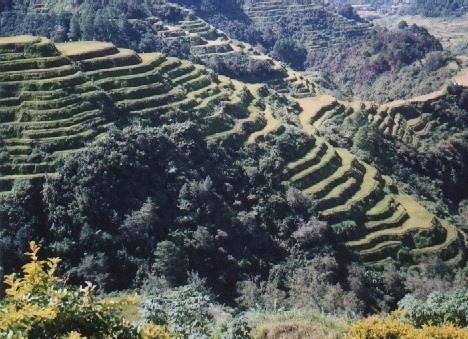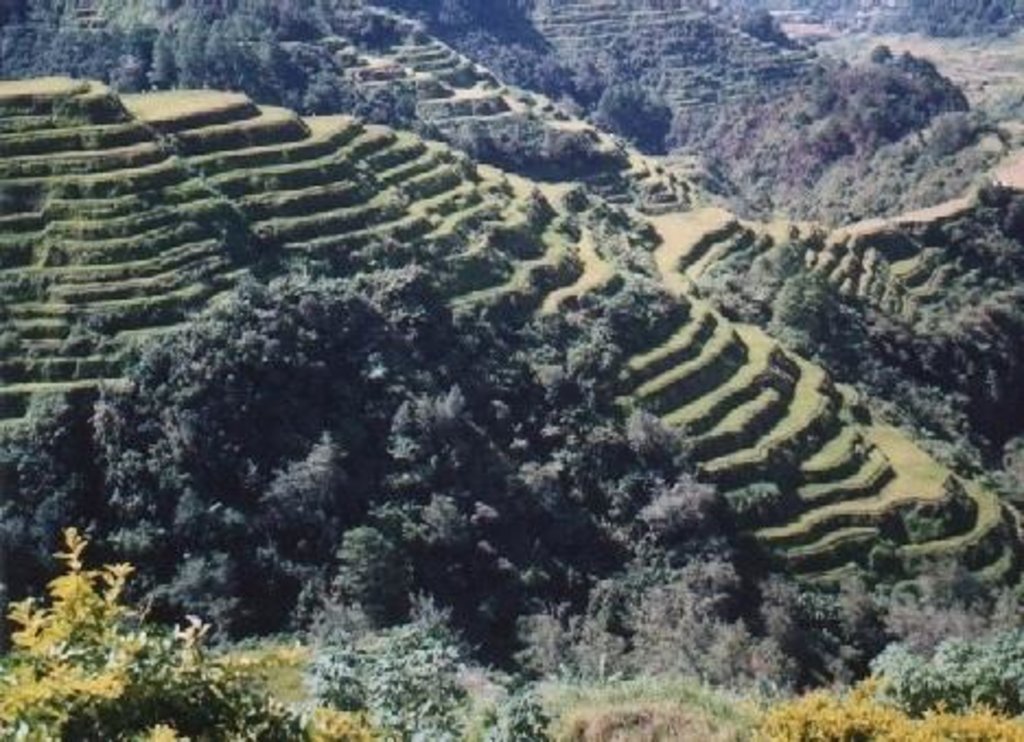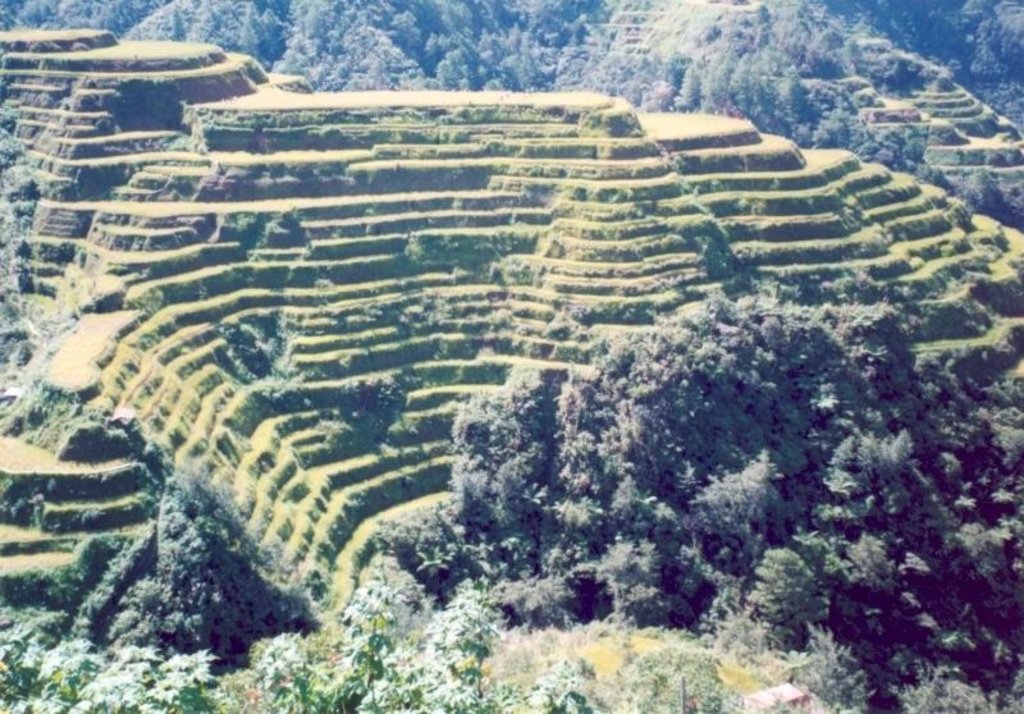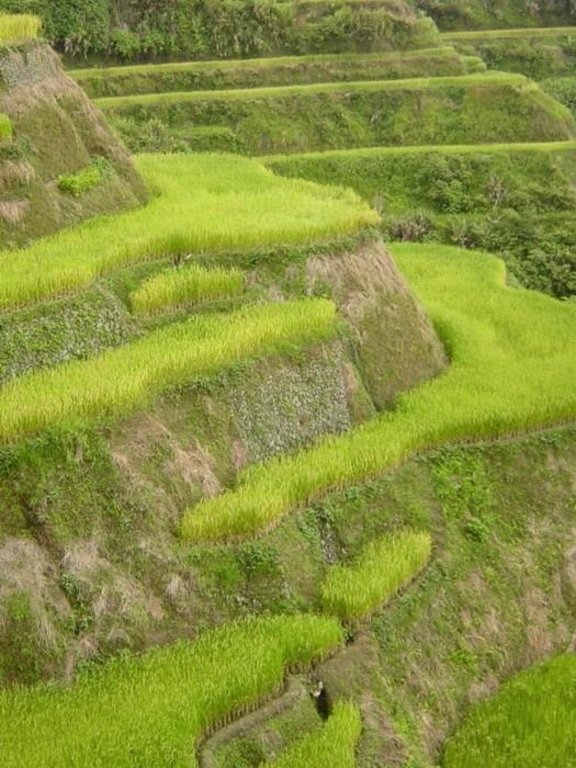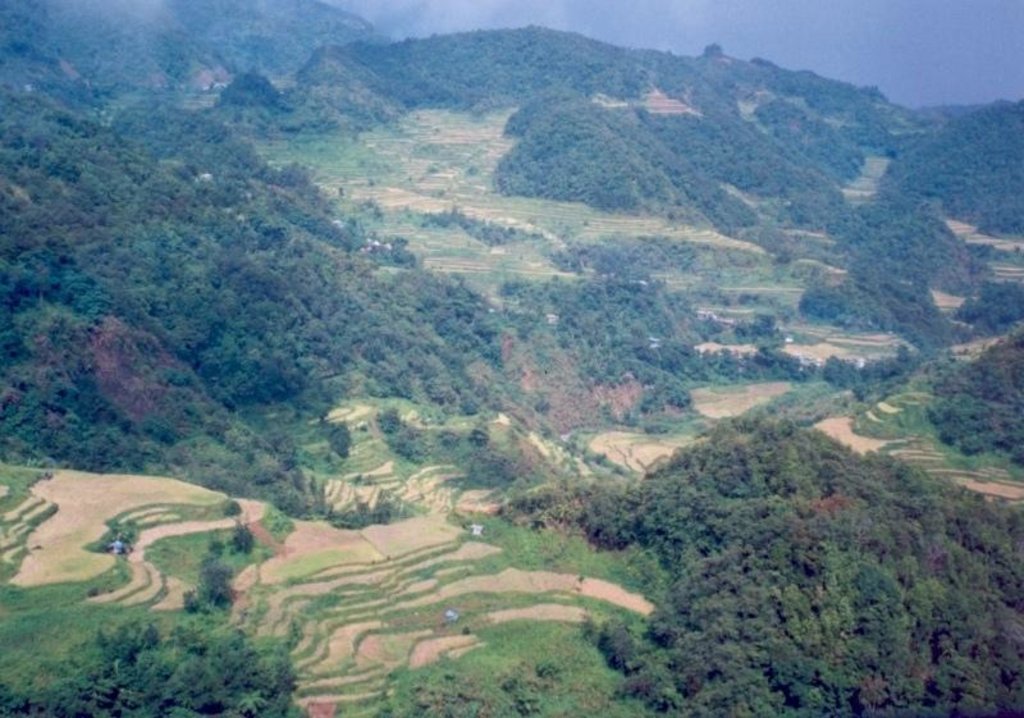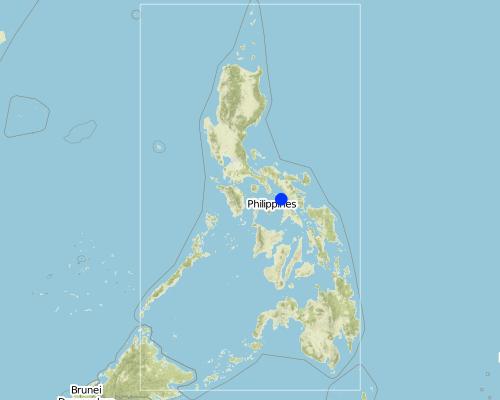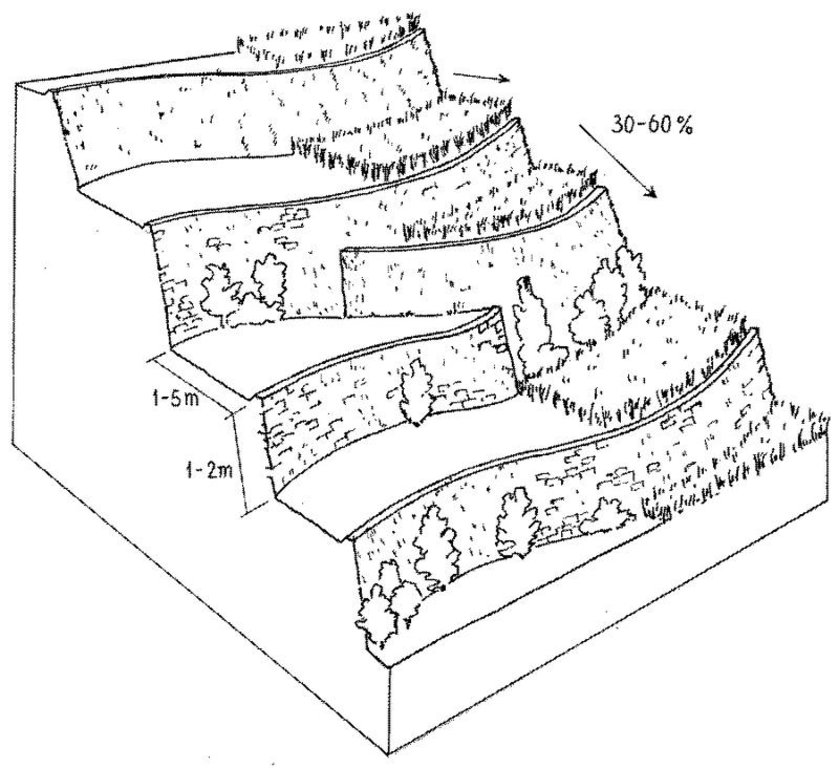Rainfed paddy rice terraces [菲律宾]
- 创建:
- 更新:
- 编制者: Philippine Overview of Conservation Approaches and Technologies
- 编辑者: –
- 审查者: Deborah Niggli
Palayan
technologies_1422 - 菲律宾
查看章节
全部展开 全部收起1. 一般信息
1.2 参与该技术评估和文件编制的资源人员和机构的联系方式
关键资源人
SLM专业人员:
Rondal Jose
joserondal@yahoo.com
Bureau of Soils and Water Management
Elliptical Road, Diliman, 1100 Quezon City, Philippines
菲律宾
1.3 关于使用通过WOCAT记录的数据的条件
(现场)数据是什么时候汇编的?:
08/09/2003
编制者和关键资源人员接受有关使用通过WOCAT记录数据的条件。:
是
1.4 所述技术的可持续性声明
这里所描述的技术在土地退化方面是否存在问题,导致无法被认为是一种可持续的土地管理技术?:
否
2. SLM技术的说明
2.1 技术简介
技术定义:
Terraces supporting rainfed paddy rice on steep mountain slopes: these have been in existence for more than a thousand years.
2.2 技术的详细说明
说明:
Terraced paddy rice on steep mountain slopes is the main method of rice cultivation in Cordillera Administrative Region (CAR) of the Philippines. This is a traditional technology: most of the terraces are at least a thousand years old. The terraces were constructed manually on steep hill slopes (30-60%) with small portions located in narrow valley bottoms. Farmers generally own one hectare or less of terraced land, and cultivation is intensive. The terraces (‘paddies’) curve along the contour, and are narrow, ranging from one to five meters in width, depending on the slope. The height of the riser is between one and two meters. Water supply for the rice crop depends on rainfall, and only one rice crop is grown
per year.
The terraces impound rainwater - average rainfall is around 2,000 mm - and thus prevent soil erosion. Soil fertility is largely maintained because the impounded water and a zero rate of erosion preserve organic matter levels. Some nutrient loss occurs however with each harvest. The terraces are multi-functional: in addition to their agricultural use, they assist in environmental protection through flood mitigation, and they contribute to biodiversity. Furthermore they have become a tourist attraction.
Land preparation is mainly manual. Farmers puddle the soil with their bare feet. Excess water is drained to the terrace below by a small opening in the lip on top of the riser. Maintenance consists basically of repairing breached bunds/risers. Every planting season, a few centimetres of soil is added. To strengthen the bunds, some farmers plant grasses, which may be cut and carried for animal fodder: napier grass (Pennisetum purpureum) is an example. It is important not to disturb the soil of the bund, as this may encourage breaching.
The area where the technology is practiced is mostly between 2,000 and 2,500 m. Because of the cool climate caused by the high elevation, crop maturity takes longer than in the lowlands. In some cases, vegetables such as cabbages and sweet potatoes are grown after the rice is harvested. The farmers, indigenous to the area, have a distinct culture that is different to lowland rice farmers. Rituals connected with farming are widely practiced. There is an added economic benefit from tourism, as people from all over the Philippines - and beyond - travel there for the spectacular views and mild climate.
2.3 技术照片
2.5 已应用该技术的、本评估所涵盖的国家/地区/地点
国家:
菲律宾
区域/州/省:
Cordillera Region
有关地点的进一步说明:
Cordillera Region
Map
×2.6 实施日期
如果不知道确切的年份,请说明大概的日期:
- 50多年前(传统)
2.7 技术介绍
详细说明该技术是如何引入的:
- 作为传统系统的一部分(> 50 年)
注释(项目类型等):
Devised by the land users themselves due to extreme necessity
3. SLM技术的分类
3.1 该技术的主要目的
- 减少、预防、恢复土地退化
- 保护生态系统
3.2 应用该技术的当前土地利用类型

农田
- 一年一作
注释:
Major land use problems (compiler’s opinion): The terraces allow crop cultivation in an area characterised by steep slopes and high rainfall. However, farming in this marginal areas is labour intensive, mechanisation is not an option on the narrow paddies, and even animal traction is rarely possible due to the steepness of the terrain and the high terrace risers. Non-terraced hill slopes are prone to very high runoff and soil erosion, production is zero.
Major land use problems (land users’ perception): High runoff and soil erosion, zero productivity.
3.3 有关土地利用的更多信息
该技术所应用土地的供水:
- 雨养
每年的生长季节数:
- 1
具体说明:
Longest growing period in days: 240
3.4 该技术所属的SLM组
- 横坡措施
3.5 技术传播
具体说明该技术的分布:
- 均匀地分布在一个区域
如果该技术均匀地分布在一个区域上,请注明覆盖的大致区域。:
- > 10,000 平方千米
注释:
Total area covered by the SLM Technology is 15000 m2.
The above provinces are basically dependent on terraced paddy rice. Most of it are rainfed with some areas under irrigation
3.6 包含该技术的可持续土地管理措施

植物措施
- V2:草和多年生草本植物

结构措施
- S1:阶地
3.7 该技术强调的主要土地退化类型

土壤水蚀
- Wt:表土流失/地表侵蚀

化学性土壤退化
- Cn:肥力下降和有机质含量下降(非侵蚀所致)
3.8 防止、减少或恢复土地退化
具体数量名该技术与土地退化有关的目标:
- 防止土地退化
- 减少土地退化
4. 技术规范、实施活动、投入和成本
4.1 该技术的技术图纸
4.2 技术规范/技术图纸说明
Layout of rainfed paddy rice terraces. The level terraces allow cultivation of paddy rice (right) on steep slopes. In some places the terrace risers are as tall as the beds are wide.
Technical knowledge required for field staff / advisors: moderate
Technical knowledge required for land users: moderate
Main technical functions: control of dispersed runoff: retain / trap, increase / maintain water stored in soil
Secondary technical functions: reduction of slope angle, reduction of slope length, indirect maintenance of fertility
Vegetative measure: grass on bunds/risers (supp.)
Structural measure: level bench terrace
4.4 技术建立活动
| 活动 | 措施类型 | 时间 | |
|---|---|---|---|
| 1. | Determination of contour lines by eye. | 结构性的 | |
| 2. | Levelling by moving soil from the upslope to the downslope part | 结构性的 | |
| 3. | Construction of bunds (lip at the terrace edge) of about 50-100 cm | 结构性的 |
4.5 技术建立所需要的费用和投入
| 对投入进行具体说明 | 单位 | 数量 | 单位成本 | 每项投入的总成本 | 土地使用者承担的成本% | |
|---|---|---|---|---|---|---|
| 劳动力 | labour | ha | 1.0 | 2500.0 | 2500.0 | 100.0 |
| 设备 | tools | ha | 1.0 | 200.0 | 200.0 | 100.0 |
| 技术建立所需总成本 | 2700.0 | |||||
注释:
Duration of establishment phase: 12 month(s)
4.6 维护/经常性活动
| 活动 | 措施类型 | 时间/频率 | |
|---|---|---|---|
| 1. | Weeding by cutting grasses on the bund/riser using hand tools. Hoeing | 植物性的 | |
| 2. | Repairing breached portion of the bunds. Adding a few centimetres | 结构性的 | |
| 3. | Land preparation by puddling. In most cases, the use of animal tractionis not possible because of the steepness of the slope and heightof the risers. | 结构性的 |
4.7 维护/经常性活动所需要的费用和投入(每年)
| 对投入进行具体说明 | 单位 | 数量 | 单位成本 | 每项投入的总成本 | 土地使用者承担的成本% | |
|---|---|---|---|---|---|---|
| 劳动力 | labour | ha | 1.0 | 30.0 | 30.0 | 100.0 |
| 设备 | tools | ha | 1.0 | 10.0 | 10.0 | 100.0 |
| 技术维护所需总成本 | 40.0 | |||||
注释:
The costs of establishment are estimates - as new terrace construction no longer takes place. The land has already been terraced for centuries. The 800 person days are for land levelling and bund construction, which comprises the main activity. The calculation was based on a land slope of 30-60%. The maintenance figure assumes regular light maintenance - and does not include major repairs to bunds.
5. 自然和人文环境
5.1 气候
年降雨量
- < 250毫米
- 251-500毫米
- 501-750毫米
- 751-1,000毫米
- 1,001-1,500毫米
- 1,501-2,000毫米
- 2,001-3,000毫米
- 3,001-4,000毫米
- > 4,000毫米
农业气候带
- 潮湿的
Thermal climate class: tropics
5.2 地形
平均坡度:
- 水平(0-2%)
- 缓降(3-5%)
- 平缓(6-10%)
- 滚坡(11-15%)
- 崎岖(16-30%)
- 陡峭(31-60%)
- 非常陡峭(>60%)
地形:
- 高原/平原
- 山脊
- 山坡
- 山地斜坡
- 麓坡
- 谷底
垂直分布带:
- 0-100 m a.s.l.
- 101-500 m a.s.l.
- 501-1,000 m a.s.l.
- 1,001-1,500 m a.s.l.
- 1,501-2,000 m a.s.l.
- 2,001-2,500 m a.s.l.
- 2,501-3,000 m a.s.l.
- 3,001-4,000 m a.s.l.
- > 4,000 m a.s.l.
5.3 土壤
平均土层深度:
- 非常浅(0-20厘米)
- 浅(21-50厘米)
- 中等深度(51-80厘米)
- 深(81-120厘米)
- 非常深(> 120厘米)
土壤质地(表土):
- 中粒(壤土、粉土)
- 细粒/重质(粘土)
表土有机质:
- 中(1-3%)
- 低(<1%)
5.6 应用该技术的土地使用者的特征
生产系统的市场定位:
- 生计(自给)
- 混合(生计/商业
非农收入:
- 收入的10-50%
说明土地使用者的其他有关特征:
Off-farm income specification: carpentry, trading, labour for neighbouring farms, overseas employment, transport services, activities associated with tourism
5.7 应用该技术的土地使用者拥有或租用的平均土地面积
- < 0.5 公顷
- 0.5-1 公顷
- 1-2 公顷
- 2-5公顷
- 5-15公顷
- 15-50公顷
- 50-100公顷
- 100-500公顷
- 500-1,000公顷
- 1,000-10,000公顷
- > 10,000公顷
5.8 土地所有权、土地使用权和水使用权
土地所有权:
- 个人,有命名
土地使用权:
- 个人
6. 影响和结论性说明
6.1 该技术的现场影响
社会经济效应
生产
作物生产
注释/具体说明:
compared with zero in the non-terraced scenario
饲料生产
饲料质量
收入和成本
农业收入
工作量
注释/具体说明:
conflicting with other income generating opportunities
社会文化影响
社区机构
国家机构
冲突缓解
生态影响
水循环/径流
多余水的排放
土壤
土壤水分
土壤流失
生物多样性:植被、动物
植物多样性
6.2 该技术的场外影响已经显现
下游洪水
下游淤积
6.4 成本效益分析
技术收益与技术维护成本/经常性成本相比如何(从土地使用者的角度看)?
短期回报:
积极
长期回报:
非常积极
6.5 技术采用
注释:
There is no trend towards spontaneous adoption of the Technology. The technology is widely accepted. As the terraces were constructed hundreds of years ago and construction of new terraces is no longer done the question of ‘adoption’ is not relevant.
6.7 该技术的优点/长处/机会
| 土地使用者眼中的长处/优势/机会 |
|---|
| Know very well the agronomy of rice production |
| 编制者或其他关键资源人员认为的长处/优势/机会 |
|---|
| Low maintenance cost |
| Farmers are well versed (very familiar) with the rice production system – it is part of their culture |
| Terracing allows paddy rice production on very steep slopes, which are prone to very high erosion and water loss in such a monsoon area. It transforms steep unproductive slopes into productive land |
6.8 技术的弱点/缺点/风险及其克服方法
| 土地使用者认为的弱点/缺点/风险 | 如何克服它们? |
|---|---|
| Lack of irrigation facilities | Construction of water harvesting structure |
| Declining yield | Fertilizer application |
| 编制者或其他关键资源人员认为的弱点/缺点/风险 | 如何克服它们? |
|---|---|
| Lack of moisture for about six months | Moisture conservation (mulching): construction of water harvesting structures for supplementary irrigation. |
| Continuous mono-cropping | Crop diversification. Other crops (such as sweet potato, cabbage, chilli) could be grown after rice towards the end of the rainy season through minimum or zero tillage. |
| Severe soil fertility decline in some locations – and therefore declining yields | Fertility enhancement using organic and inorganic sources (manure, crop residues, compost, fertilizers etc). |
7. 参考和链接
7.1 信息的方法/来源
- 实地考察、实地调查
- 与土地使用者的访谈
7.2 参考可用出版物
标题、作者、年份、ISBN:
Breemen van N, Oldeman LR, Plantinga WJ and Wielemaker WG (1970) The Ifugao Rice Terraces. In: Miscellaneous papers (7) 1970,eds. N van Breemen et al Landbouwhogeschool, Wageningen, The Netherlands.
链接和模块
全部展开 全部收起链接
无链接
模块
无模块


